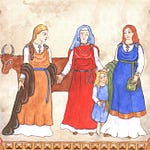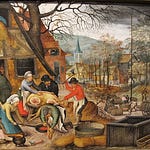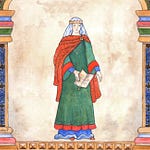Ælfgif-who? is a newsletter and podcast about the lives of early medieval English women. Click on the podcast player if you’d like to hear this newsletter read aloud in my appealing Yorkshire accent.

Cynethryth: Mercia’s Forgotten Queen?
Cynethryth, the queen of King Offa of Mercia, flourished in the period 770-98, though her exact birth and death dates are uncertain. She was one of England’s most extraordinary queens, but now, very few know her name.
In the early medieval period, the area that is now England was split into a number of smaller kingdoms. During Cynethryth’s lifetime, Mercia was the most powerful of these kingdoms, and was said to dominate the entire area south of the Humber estuary. King Offa and Queen Cynethryth presided over this powerful kingdom in the second half of the eighth century.
Surviving evidence indicates that during the latter part of Offa’s reign, Queen Cynethryth’s status was emphasised to a remarkable extent. It is possible to piece together a biography that reveals her to be an extremely important figure.
There are dozens of surviving coins depicting Queen Cynethryth’s name and image.1 One side shows her face and the inscription ‘EOBA’, the name of the moneyer who minted the coin, while the other side reads ‘CYNETHRYTH REGINA M(erciorum)’, a Latin inscription meaning ‘Queen Cynethryth of Mercia’.
These coins are remarkable in two ways - they are the earliest coins depicting a queen in early medieval western Europe, and they contain the earliest portrait of any English queen. The Byzantine Empress Irene, the first to rule in her own right, had her own coinage around the same time in the 780s, though it is unlikely one inspired the other. A more likely inspiration for Cynethryth’s coinage is ancient Roman models of coins issued in the name of emperors wives. Stylistic connections have been made between Cynethryth’s coins and those of Faustina, wife of Emperor Antoninus Pius, and coins of Helena, mother of Constantine, were also in circulation in this period.
Emperor Charlemagne and his third wife Fastrada took inspiration from Cynethryth’s coins when Fastrada had coins minted in her own name in the 790s, highlighting that Cynethryth was a trailblazer on a European scale!
Some historians that Cynethryth’s coins functioned as a status symbol for King Offa, who used them to present himself like a powerful Roman Emperor. However, the sheer number of these coins and the diversity of their design (at least thirty two different dies were used to cast these coins) suggests that they had a different function to Offa’s regular coinage. It is entirely possible that the coins minted by Eoba, a moneyer from Canterbury, were a grant of income for use by Cynethryth herself. As these coins were minted in the kingdom of Kent, they are an example of the wide power-base the royal family of Mercia enjoyed. Indeed, Cynethryth’s coins have been found in locations as widespread as Kent, Mercia, Essex, Sussex, East Anglia and Wessex.
Another thing that sets Cynethryth apart is how she is styled as queen in the strongest terms - 'regina Merciorum' on her coins. The description is also used on charters that Cynethryth co-signed with Offa from 770, when their son Ecgfrith was born, until the 780s, and in one instance she is even named 'dei gratia regina Merciorum' (queen of Mercia by the grace of God). She is the first queen to have such a formula indicating her queenship was derived directly from God himself. Cynethryth and Offa’s son, Ecgfrith, may have been the earliest anointed English king - the ‘Anglo Saxon Chronicles’ tell us that he was ‘hallowed’ to king while his father was still alive, framing his inauguration as Offa’s successor in sacred terms. Offa, Cynethryth and Ecgfrith were the first royal family in England to really take advantage of the growing ideology of religious monarchical power that was developing on the continent.
In letters written by Alcuin2, a leading English scholar at the Carolingian court, Cynethryth is referred to as the dispensatrix domus, or ‘steward of the household’. Though none of Alcuin’s letters to Cynethryth survive, there is evidence that he knew her well and corresponded with her: in one letter to a nun named Hunthryth, Alcuin requests that she speak with Cynethryth on his behalf, emphasising his loyalty to her and adding that he would have written directly to Cynethryth ‘if the king’s business had permitted her to read it’. One other letter, also to a nun, may mention Cynethryth: Alcuin asks the nun to ‘greet that dear lady in my name’. The letter then states that Alcuin ‘always desired her progress towards the salvation of her soul, for which she has always had to strive, but now most of all since she has survived the death of her most excellent lord the king. I wish her to live in happiness and to serve God faithfully’.
If it was indeed Cynethryth about whom Alcuin was writing, he need not have been concerned about her survival after Offa’s death in 796. After his death, Cynethryth became Abbess of Cookham, which had been bequeathed into her personal ownership during Offa’s lifetime. Her power and status had been secured in her husband’s lifetime and were part of an ongoing dynastic manoeuvre that was designed specifically to outlive him. During her son Ecgfrith's brief reign of under a year (for he died of an unexpected illness) she attested two of his charters. At the Synod of Clovesho in 798 Cynethryth was named as Offa’s heir during a property dispute. She likely played a major role in the management of an extensive network of monasteries and their land, including Glastonbury Abbey and Fladbury where her daughter Æthelburh was abbess.
Cynethryth rose to prominence as Offa’s queen with the birth of their son and heir, but her life and influence outlived both these men. As part of a royal family whose legitimacy was stressed in religious terms, Cynethryth was able to enjoy an exalted status that also had practical applications - she was an important landholder, with her own income, who retired as an abbess with a position of great authority. Despite her remarkable career, at the centre of a period of Mercian political dominance, there has not yet been a substantial historical study on Cynethryth’s life. She is one of the most important ‘forgotten’ queens of the early medieval period.
Suggestions for further reading:
Cynethryth is a relatively unexamined queen. If you’re looking for more in-depth information I would recommend trying to get hold of ‘Mercia: An Anglo-Saxon Kingdom in Europe’ (2005) edited by Michelle Brown and Carol Farr. It’s an academic book, so may be expensive to buy, but you could try requesting it from your local library or seeing if your nearest university library has a copy. Alternatively, a lot of it is available on the Google Books preview. As well as information on Mercia in general it contains an essential article about ‘Political Women in Mercia’ written by Pauline Stafford.
If you are interested in Cynethryth’s coin I would also recommend looking into another unusual coin minted in Offa’s reign: Offa’s gold dinar. This Islamic-style coin has an Arabic inscription, demonstrating the influence Islamic society had in ninth-century Mercia. You could start with this British Library article.
Image of Cynethryth’s coin reproduced from Classical Numismatic Group http://www.cngcoins.com, under the following license: https://creativecommons.org/licenses/by-sa/3.0/deed.en
Alcuin, Alcuin of York: His Life and Letters, trans. by Stephen Allott (William Session Limited, 1974)














Share this post